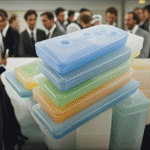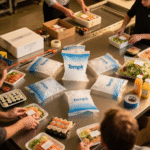Pacotes de gelo seco para envio 48 Horas: Como ter sucesso
Se você precisar de um espera de dois dias confiável de dois dias, Comece com a quantidade certa de gelo seco, a embalagem certa, e os rótulos certos. A linha de base comum é Igualmente igual peso de gelo seco na carga útil congelada; Em seguida, ajuste a estação e o isolamento, e verifique com um registro de dados. Pacotes Mark UN1845 (Gelo seco/dióxido de carbono, sólido) e siga as regras da IATA/Air -Carrier.
-
Dimensione seu líquido de arrefecimento para Pacotes de gelo seco para envio 48 horas Usando um estimador prático.
-
Construa uma embalagem robusta isso impede que o descongelamento e a etiqueta falhas na primeira tentativa.
-
Conhecer regulamentos (Aqui está Pi 954, FedEx/UPS/USPS) sem adivinhação.
-
Validar e melhorar com ISTA 7E/padrão 20 e monitoramento simples.
Quanta gelo seco fazem Pacotes de gelo seco para envio 48 horas exigir?
Resposta curta: Comece perto 1:1 (gelo seco : Produto congelado por peso) por ~ 48 horas, Em seguida, adicione 25–50% para pistas quentes ou verão e reduza se você usar isolamento de R -R. Sempre verifique com um madeireiro.
Por que funciona: Gelo seco não derrete; isto Sublelimates É isso. A taxa de sublimação depende da carga de calor e do isolamento, Então, a espessura da rota e da parede. O trabalho de segurança da aviação enfatiza a medição seu taxa em condições realistas, em vez de confiar em reivindicações de fornecedores.
Estimador rápido de 48 horas (usar, então teste)
Exemplo: 6Carga útil -LB, Summer Hot Lane, EPS 1.5″: 6 × 1.35 × 1.15 ≈ 9.3 lb ⇒ pacote 9.5–10 lb. e validar.
| Carga útil (Libra) | Comece a gelo seco (Libra) | Quando adicionar mais | O que isso significa para você |
|---|---|---|---|
| 4 | 4–5 | Summer/Hot Lane | 48h confiável se EPS ≥1,5″ |
| 8 | 8–10 | Multi -Handoff | Adicione VIP se o peso estiver apertado |
| 12 | 12–15 | Pistas muito quentes | Logger + VIP recomendado |
Dicas práticas que você pode usar hoje
-
Produto pré -congelado com força (<-18 ° C.) e embalagens relaxantes para cortar a carga de calor precoce.
-
Coloque o gelo seco por cima (Air frio afunda) e Deixe os caminhos de ventilação; Nunca sele o gelo seco em uma bolsa.
-
Eliminar vazios com kraft ou almofadas para reduzir a convecção e a liquidação.
Caso do mundo real: Um envio de padaria 6 Libra de doces congelados no verão se mudaram de 1″ a 1,75″ EPS e levantou gelo seco de 6 lb para 8 Libra. O núcleo ficou abaixo de -10 ° C para 52 horas em uma pista quente.
Qual embalagem mantém Pacotes de gelo seco para envio 48 horas confiável?
Construa um apertado, sistema ventilado: caixa isolada (EPS 1.5–2.0″ ou VIP), Produto centrado e ensacado, gelo seco por cima, e ventilação clara. Nunca deixe secar a comida de toque de gelo seco. Adicionar gel/pcm para buffer o quente de última hora ou para evitar a exposição muito descarregada.
Embalagem híbrida (gelo seco + PCM): Quando e por quê
-
Kits de amostragem de sorvete: Adicione tijolos PCM de -20 ° C para evitar o degelo parcial na entrega.
-
Pacotes de refeições congeladas: Adicione pacotes de gel de 0 ° C para buffer pós -união.
-
Biológicos sensíveis à temperatura: Adicione o PCM de raça estreita para evitar o excesso de resfriamento.
Que regulamentos se aplicam a Pacotes de gelo seco para envio 48 horas?
Para o ar: marca “UN1845, Gelo Seco (ou dióxido de carbono, sólido)” e mostrar Peso de gelo seco líquido em kg; garantir ventilação; Aplique a Aula 9 rótulo (100 mm quadrado). Se Gelo seco é o único bem perigoso, FedEx não requer Declaração de um remetente; Siga sua ajuda no trabalho para alturas de caráter (≥12mm quando a capacidade do pacote >30 kg). UPS e Aqui está Pi 954 As regras se aplicam da mesma forma. USPS permite parcelas domésticas de gelo seco sob Instruções de embalagem 9a.
Nota do consumidor: As companhias aéreas costumam limitar o gelo seco na bagagem de passageiros em 2.5 kg (5.5 Libra)- isso é para bagagem, não carga. Verifique sua operadora se você estiver perto desse limite.
Básico de segurança: Use luvas isoladas; trabalho em áreas ventiladas; Não guarde gelo seco em salas seladas ou recipientes herméticos. Considere o monitoramento de co₂ onde você encaixa cargas de saída.
Validação e monitoramento: Prove sua performance de 48 horas
Qualifique seu design com o ISTA 7E (Perfis de verão/inverno) e documento para padrão 20. Adicione um logger USB/NFC às execuções de qualificação e um plano de amostragem para parcelas vivas. USP <1079> promove uma abordagem baseada em risco e monitoramento contínuo durante a distribuição.
3Plano de Etapa
-
Teste de bancada: execute 7e perfis; Capture núcleo e temperaturas próximas à parede.
-
Piloto da pista: Envie para uma pista quente com 25 a 50% de reserva de ódio seco; Curvas de revisão.
-
POPS + treinamento: codificar as embalagens, pesos, rótulos, avisos do destinatário.
2025 tendências moldando Pacotes de gelo seco para envio 48 horas
Fornecimento de co₂: A saída do Merchant Co₂ dos EUA é para baixo 2025 Devido a perdas de plantas e manutenção de rotina, Embora as interrupções tenham sido gerenciadas -Planejar contratos e buffers à frente das estações de pico.
Monitoramento: A adoção do fluxo de temperatura continua subindo 2035, Melhorando a rastreabilidade e a resolução de disputas.
Último em um olhar
-
Clareza da transportadora: Páginas IATA/FEDEX/UPS atualizadas marcas e declarações afiar.
-
Foco de validação: FAA TRABALHO ESTRESSA medido taxas de sublimação em condições realistas.
-
Entrega de alimentos: A orientação da melhor prática da FDA enfatiza o controle de temperatura, rotulagem, e transferência.
Insight de mercado: co₂ mais apertado e conformidade mais forte empurram mais remetentes para Forros VIP ou híbridos Para reduzir a massa de gelo seco e o frete. Madeiras e etiquetas inteligentes suportam documentação no estilo FSMA.
Perguntas frequentes
Quantos quilos de gelo seco mantêm 10 libras de carne congelada por 48h?
Comece próximo 1:1 (≈10lb), adicionar 25–35% Para pistas de verão ou quentes, e verifique com um madeireiro.
Preciso de uma declaração de remetente se o gelo seco for o único bem perigoso?
Não para a FedEx Express, desde que você marque a UN1845 e o peso líquido corretamente; Siga sua ajuda no trabalho.
Qual tamanho de rótulo e texto devo usar?
Aplique a Aula 9 rótulo (100 mm) e garantir as marcações; FedEx pedidos ≥12mm altura do texto quando a capacidade do pacote >30 kg.
Posso enviar com USPS?
Sim, Somente doméstico. O pacote deve desabafar e encontrar Instruções de embalagem 9a.
Existe um limite de 5,5 -LB para remessas de ar?
Páginas de tiro ao ar para consumidores costumam citar 5.5 Libra (2.5 kg) limiares; sempre confirme o nível de operadora e serviço para sua remessa.
Resumo & Recomendações
Usar Pacotes de gelo seco para envio 48 horas com um 1:1 taxa inicial, Isolamento forte, Cologem superior, e ventilação adequada. Rotule UN1845 com peso líquido, Siga as regras da IATA/Transportadora, e Validar com o ISTA 7E além de um madeireiro. Plano embalagens sazonais e manter Contingência de co₂ Para proteger os níveis de margem e serviço.
PRÓXIMOS PASSOS:
-
Execute o estimador para o seu sku superior e reserve um Verão/inverno teste. 2) Publique a Nota de assistência ao destinatário (“Contém gelo seco - use luvas; aberto em uma área ventilada ”). 3) Padronizar rótulos e manutenção de registros. Precisa de uma mão? Entre em contato com o Tempk para um plano de validação de 48 horas específico de pista.
Sobre Tempk
Designs Tempk, testes, e fornece embalagens controladas por temperatura - pacotes de gel e "átores secos", remetentes isolados, Tampas de paletes, E mais - apoiado por um laboratório certificado pelo CNAS e QA auditado. Nós construímos 48 horas validadas na pista embalagens e designs híbridos que cortam o uso total de ódio seco, mantendo os resultados confiáveis.
























